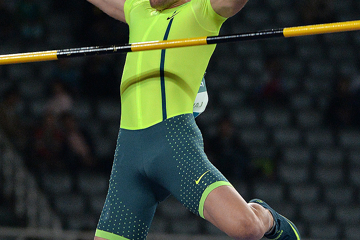Omar McLeod at the press conference for the IAAF Diamond League meeting in Shanghai (© Errol Anderson)
It is said that there are no friends in politics, but it seems there is nothing but friends in the hurdles.
That was the impression given, at least, when world leader Omar McLeod, Olympic champion and world record-holder Aries Merritt and 2013 world champion David Oliver addressed the press conference on Friday (13) ahead of the IAAF Diamond League meeting in Shanghai.
Proceedings got under way with a question to McLeod about how he is handling the pressure of being the ‘man to watch’ in the 110m hurdles this year following his world indoor 60m hurdles title and two world leads in his first two races outdoors.
He also became the first sub-13-second sprint hurdler to run faster than 10 seconds for the 100m flat.
“There’s no pressure,” McLeod responded. “I’m happy to be at this level.”
McLeod said that the indoor title was ‘a stepping stone’ to outdoors. “You can use it to your advantage, but you’ve still got to make the transition to outdoors.”
The next questioner observed that three of the top hurdlers in the world must be fiercely competitive, “but you all get on very well. How does that dynamic work?”
As smoothly, it seems, as McLeod deferring first right of response to Oliver and then Merritt, presumably on the basis of seniority.
Oliver said the 10 obstacles were their main rivals.
“I’ve always thought that we’re not so much racing each other. It’s more about the 10 barriers in front of us,” he said. “The hurdles are our main competitors. Off the track, I get on with everybody.”
Merritt drew a line between on and off the track.
“Our main focus is on the barriers. You start worrying about someone else and you lose your focus.
“Off the track we can be friends; on the track, it’s business.”
McLeod’s view was that the race was hard enough without adding in personal animosities.
“[Being friends] makes it easier,” said the Jamaican. “The event is hard enough. There are 10 hurdles and eight lanes. It’s easier to focus on 10 barriers than it is to focus on seven other people.”
Merritt was asked whether his health problems represented an ‘11th hurdle’.
“After Beijing I had surgery on 1 September,” he said, “but not many people know that I had a second surgery seven weeks later. I had a complication; they cut me back open and re-positioned the kidney because I had a haematoma that was actually rushing the kidney.”
Merritt said he was “months behind my competitors” where he usually is at this stage of the season, because he had not been able to resume even light training until December last year. Despite that, he was still “running decent” and he would try “to technique my way through”.
“I feel like I’ll be ready when I need to be,” he said. “It’s been a struggle. I tried to run an indoor season because the World Indoors were in America, but I had pain whenever my trail legs hits the incision area. There’s still slight discomfort.
“It’s something my body has to get used to. It’s a struggle, but over time it will get better and better. It’s different, just something I’m going to have to adapt to.
“Body chemistry is normal. I’m full of energy. I’ve just got to try to get my body back to where I was before.”
Olympic pole vault champion Renaud Lavillenie was asked whether we can expect a world record from him in 2016, given that it is a special year.
Lavillenie replied that because it was a special year, a world record was not as high a priority.
“This year is Olympic year. The goal is not the world record, but the gold medal in Rio,” he said.
“My main goal is to be consistent at six metres because that is an area not a lot of others can reach.”
Having said that, however, Lavillenie added: “The world record is not my main goal, but I’m always able to make a good surprise.”
Asked whether he had made any changes in preparation for Olympic year, Lavillenie said he had not changed anything major since moving from a 5.10m to a 5.20m pole three years ago.
“I went from 6.03m to 6.16m, so it was the first big step.”
But he had not made many other changes.
“For one year, you don’t change anything (much),” he said. “You see what has worked for the past few years. It’s better not to make big changes to what you are used to in your training.”
Relays are not on the Diamond League program, but there is a men’s and women’s 4x100m being run here and two of the men who featured on the Chinese team that took silver at the 2015 World Championships were at the press conference.
Zhang Peimeng said the Chinese aim for this year was to make the Olympic final.
“We regarded the success of the relay in Beijing as a miracle,” said Zhang, “because of our own efforts but also some luck. USA made mistakes and other European teams did not rise to the occasion.
“The target (for Rio) is the final.”
Len Johnson for the IAAF





